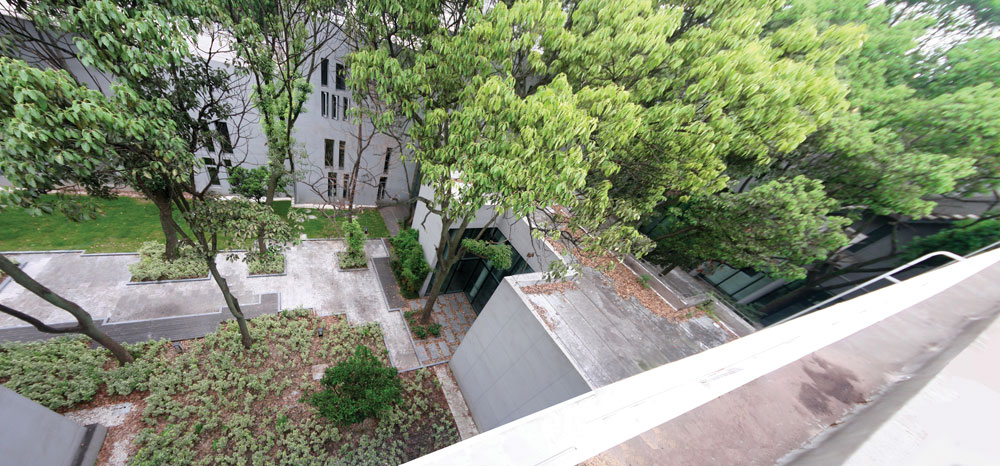LEAF Awards 2013 Winner: Chinese Academy of Sciences IOT Center

Best Sustainable Development (Environmental)
SKEW Collaborative, Jiading District, Shanghai
The site for this new exhibition centre and laboratories was the former 1962 Soviet-designed low-density office cluster sitting among a heavily wooded compound. The design sought to minimise the carbon footprint of new construction by retaining as much of the existing fabric, with selective demolition and reconstruction. The newly configured complex possesses a series of intimate courtyards, weaving new architecture through 45 mature trees and existing building structures. New laboratories, offices and exhibition spaces are organised around courtyards and terraces on two or three levels, each having views and access to the natural environment.
SKEW Collaborative, Jiading District, Shanghai
The site for this new exhibition centre and laboratories was the former 1962 Soviet-designed low-density office cluster sitting among a heavily wooded compound. The design sought to minimise the carbon footprint of new construction by retaining as much of the existing fabric, with selective demolition and reconstruction. The newly configured complex possesses a series of intimate courtyards, weaving new architecture through 45 mature trees and existing building structures. New laboratories, offices and exhibition spaces are organised around courtyards and terraces on two or three levels, each having views and access to the natural environment.
The cluster of buildings were initially separated into two distinct blocks that had , over time, accumulated additional barnacle-like extensions that are haphazardly attached to the main body. These included additional mezzanine levels and blocks constructed out of lightweight materials, and many had independent access points, resulting in a convoluted circulation system and an accumulative structural system. In this way, the site could be read as an archaeological artefact that documents its own history – from initial growth in the 1960s through the 90s, to its decline that paralleled the relocation of industry out of Shanghai to the periphery as the city entered into an economy based on skills and services.
This project strove for sustainability through the preservation of much of the original structure. At the same time, the existing mature camphors and pines were one of the highlights of the site, and care was taken to weave the new architecture through the dense foliage without destroying a single tree. To this end, notches were carved out of the new bridge buildings as well as the original carcass, to frame the landscape spatially and visually. Exterior terraces at the level of the tree crowns were created to allow closer relations between the end users and nature, resulting in the effect of literally “walking amongst the trees”.
This project strove for sustainability through the preservation of much of the original structure. At the same time, the existing mature camphors and pines were one of the highlights of the site, and care was taken to weave the new architecture through the dense foliage without destroying a single tree. To this end, notches were carved out of the new bridge buildings as well as the original carcass, to frame the landscape spatially and visually. Exterior terraces at the level of the tree crowns were created to allow closer relations between the end users and nature, resulting in the effect of literally “walking amongst the trees”.
The original fenestration monotonously framed views to the exterior, as was befitting of the buildings’ industrial nature. The new window organisation echoes the organic rhythm of the trees, while providing the user with multiple ways of viewing nature – through grouped windows, long vertical strip windows, large framed openingsor and floor-to-ceiling glazing. This multiplicity is not merely visual – the façade, through its tectonic articulation, increases the contact between building and landscape, interior and exterior. At the same time, ventilated corridors permit natural air circulation and allow light to enter the long spaces, literally bringing the outdoors in through a transition zone, while reducing the overall energy load of the complex.
Client: Mr Li Hua, Chinese Academy of Sciences
Size of project: 14,000m²
Cost: RMB 23 million
Start date: May 2010
Completion date: January 2012
Client: Mr Li Hua, Chinese Academy of Sciences
Size of project: 14,000m²
Cost: RMB 23 million
Start date: May 2010
Completion date: January 2012
LEAF Awards jury statement
Sustainability can be achieved by various means, and is optimally an integrative process. This project is very creative in its reuse, with great attention to the natural landscape. The site for this new exhibition center and laboratories was the former 1962 Soviet-designed low-density office cluster sitting amongst a heavily wooded compound. The design successfully minimizes the carbon footprint of new construction by retaining as much of the existing fabric, with selective demolition and reconstruction. A double skin and a new fenestration system were developed in order to rationalize and produce new envelopes suitable for the new programs and the environment.
The newly configured complex’s series of intimate courtyards weaves new architecture throughout mature trees and existing building structures, while new laboratories, offices and exhibition spaces are organized around courtyards and terraces on two to three levels, each with views and access to the natural environment.
The strategic insertions of new forms and voids within the structural framework of the original complex, and the dialogue between the new and the old is highly effective: it enhances daylight access and natural ventilation, and deploys the landscape of mature camphor and pine trees most imaginatively.
The strategic insertions of new forms and voids within the structural framework of the original complex, and the dialogue between the new and the old is highly effective: it enhances daylight access and natural ventilation, and deploys the landscape of mature camphor and pine trees most imaginatively.
